Grokking Deep Reinforcement Learning MEAP V11
Copyright
Welcome
Brief contents
Chapter 1: Introduction to deep reinforcement learning
What is deep reinforcement learning?
Deep reinforcement learning is a machine learning approachto artificial intelligence
Deep reinforcement learning is concernedwith creating computer programs
Deep reinforcement learning agentscan solve problems that require intelligence
Deep reinforcement learning agentsimprove their behavior through trial-and-error learning
Deep reinforcement learning agentslearn from sequential feedback
Deep reinforcement learning agentslearn from evaluative feedback
Deep reinforcement learning agentslearn from sampled feedback
Deep reinforcement learning agentsutilize powerful non-linear function approximation
The past, present, and futureof deep reinforcement learning
Recent history of artificial intelligenceand deep reinforcement learning
Artificial intelligence winters
The current state of artificial intelligence
Progress in deep reinforcement learning
Opportunities ahead
The suitability of deep reinforcement learning
What are the pros and cons?
Deep reinforcement learning's strengths
Deep reinforcement learning's weaknesses
Setting clear two-way expectations
What to expect from the book?
How to get the most out of the book?
Deep reinforcement learning development environment
Summary
Chapter 2: Mathematical foundations of reinforcement learning
Components of reinforcement learning
Examples of problems, agents, and environments
The agent: The decision-maker
The environment: Everything else
Agent-environment interaction cycle
MDPs: The engine of the environment
States: Specific configurations of the environment
Action: A mechanism to influence the environment
Transition function: Consequences of agent actions
Reward signal: Carrots and sticks
Horizon: Time changes what's optimal
Discount: The future is uncertain, value it less
Extensions to MDPs
Putting it all together
Summary
Chapter 3: Balancing immediate and long-term goals
The objective of a decision-making agent
Policies: Per-state action prescriptions
State-value function: What to expect from here?
Action-value function: What to expect from here if I do this?
Action-advantage function: How much better if I do that?
Optimality
Planning optimal sequences of actions
Policy Evaluation: Rating policies
Policy Improvement: Using ratings to get better
Policy Iteration: Improving upon improved behaviors
Value Iteration: Improving behaviors early
Summary
Chapter 4: Balancing the gathering and utilization of information
The challenge of interpreting evaluative feedback
Bandits: Single state decision problems
Regret: The cost of exploration
Approaches to solving MAB environments
Greedy: Always exploit
Random: Always explore
Epsilon-Greedy: Almost always greedy and sometimes random
Decaying Epsilon-Greedy: First maximize exploration, then exploitation
Optimistic Initialization: Start off believing it's a wonderful world
Strategic exploration
SoftMax: Select actions randomly in proportion to their estimates
UCB: It's not about just optimism; it's about realistic optimism
Thompson Sampling: Balancing reward and risk
Summary
Chapter 5: Evaluating agents' behaviors
Learning to estimate the value of policies
First-visit Monte-Carlo: Improving estimates after each episode
Every-visit Monte-Carlo: A different way of handling state visits
Temporal-Difference Learning: Improving estimates after each step
Learning to estimate from multiple steps
N-step TD Learning: Improving estimates after a couple of steps
Forward-view TD(λ): Improving estimates of all visited states
TD(λ): Improving estimates of all visited states after each step
Summary
Chapter 6: Improving agents' behaviors
The anatomy of reinforcement learning agents
Most agents gather experience samples
Most agents estimate something
Most agents improve a policy
Generalized Policy Iteration
Learning to improve policies of behavior
Monte-Carlo Control: Improving policies after each episode
Sarsa: Improving policies after each step
Decoupling behavior from learning
Q-Learning: Learning to act optimally, even if we choose not to
Double Q-Learning: a max of estimates for an estimate of a max
Summary
Chapter 7: Achieving goals more effectively and efficiently
Learning to improve policies using robust targets
Sarsa(λ): Improving policies after each step based on multi-step estimates
Watkins's Q(λ): Decoupling behavior from learning, again
Agents that interact, learn and plan
Dyna-Q: Learning sample models
Trajectory Sampling: Making plans for the immediate future
Summary
Chapter 8: Introduction to value-based deep reinforcement learning
The kind of feedback deep reinforcement learning agents use
Deep reinforcement learning agents deal with sequential feedback
But, if it is not sequential, what is it?
Deep reinforcement learning agents deal with evaluative feedback
But, if it is not evaluative, what is it?
Deep reinforcement learning agents deal with sampled feedback
But, if it is not sampled, what is it?
Introduction to function approximation for reinforcement learning
Reinforcement learning problems can have high-dimensional state and action spaces
Reinforcement learning problem scan have continuous state and action spaces
There are advantages when using function approximation
NFQ: The first attempt to value-based deep reinforcement learning
First decision point: Selecting a value function to approximate
Second decision point: Selecting a neural network architecture
Third decision point: Selecting what to optimize
Fourth decision point: Selecting the targets for policy evaluation
Fifth decision point: Selecting an exploration strategy
Sixth decision point: Selecting a loss function
Seventh decision point: Selecting an optimization method
Things that could (and do) go wrong
Summary
Chapter 9: More stable value-based methods
DQN: Making reinforcement learning more like supervised learning
Common problems in value-based deep reinforcement learning
Using target networks
Using larger networks
Using experience replay
Using other exploration strategies
Double DQN: Mitigating the overestimation of action-value functions
The problem of overestimation, take two
Separating action selection and action evaluation
A solution
A more practical solution
A more forgiving loss function
Things we can still improve on
Summary
Chapter 10: Sample-efficient value-based methods
Dueling DDQN: A reinforcement-learning-aware neural network architecture
Reinforcement learning is not a supervised learning problem
Nuances of value-based deep reinforcement learning methods
Advantage of using advantages
A reinforcement-learning-aware architecture
Building a dueling network
Reconstructing the action-value function
Continuously updating the target network
What does the dueling network bring to the table?
PER: Prioritizing the replay of meaningful experiences
A smarter way to replay experiences
Then, what is a good measure of "important" experiences?
Greedy prioritization by TD error
Sampling prioritized experiences stochastically
Proportional prioritization
Rank-based prioritization
Prioritization bias
Summary
Chapter 11: Policy-gradient and actor-critic methods
REINFORCE: Outcome-based policy learning
Introduction to policy-gradient methods
Advantages of policy-gradient methods
Learning policies directly
Reducing the variance of the policy gradient
VPG: Learning a value function
Further reducing the variance of the policy gradient
Learning a value function
Encouraging exploration
A3C: Parallel policy updates
Using actor-workers
Using n-step estimates
Non-blocking model updates
GAE: Robust advantage estimation
Generalized advantage estimation
A2C: Synchronous policy updates
Generalized advantage estimation
A2C: Synchronous policy updates
Generalized advantage estimation
A2C: Synchronous policy updates
Weight-sharing model
Restoring order in policy updates
Summary
Chapter 12: Advanced actor-critic methods
DDPG: Approximating a deterministic policy
DDPG uses lots of tricks from DQN
Learning a deterministic policy
Exploration with deterministic policies
TD3: State-of-the-art improvements over DDPG
DDPG uses lots of tricks from DQN
Learning a deterministic policy
Exploration with deterministic policies
TD3: State-of-the-art improvements over DDPG
Double learning in DDPG
Smoothing the targets used for policy updates
Delaying updates
SAC: Maximizing the expected return and entropy
Adding the entropy to the Bellman equations
Learning the action-value function
Learning the policy
Automatically tuning the entropy coefficient
PPO: Restricting optimization steps
Using the same actor-critic architecture as A2C
Batching experiences
Clipping the policy updates
Clipping the value function updates
Summary

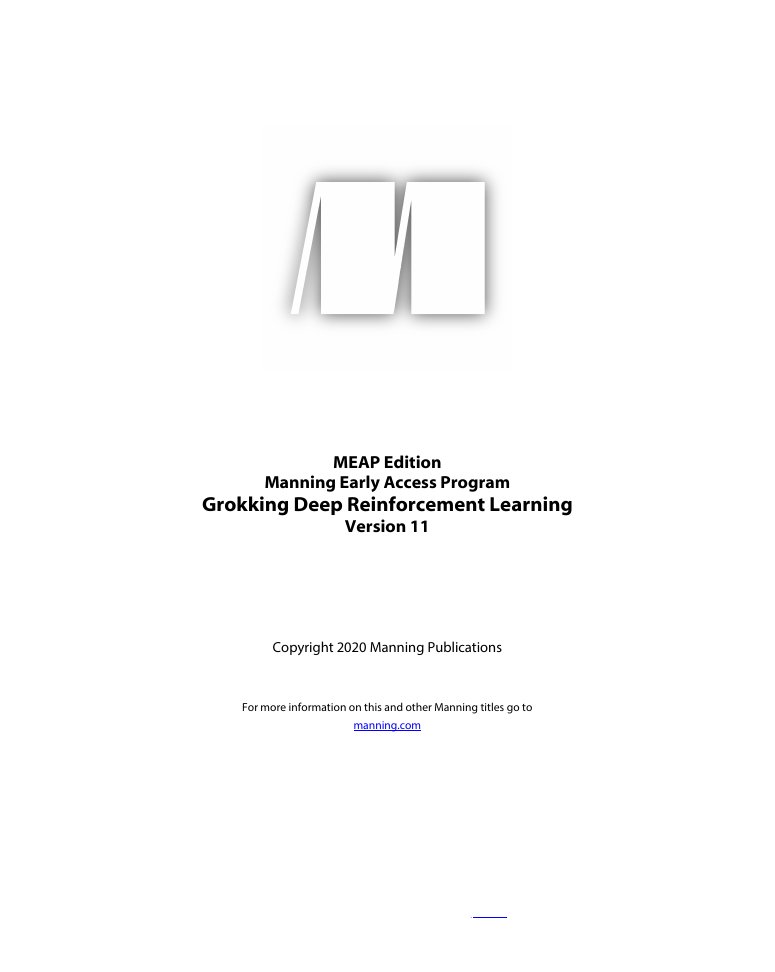
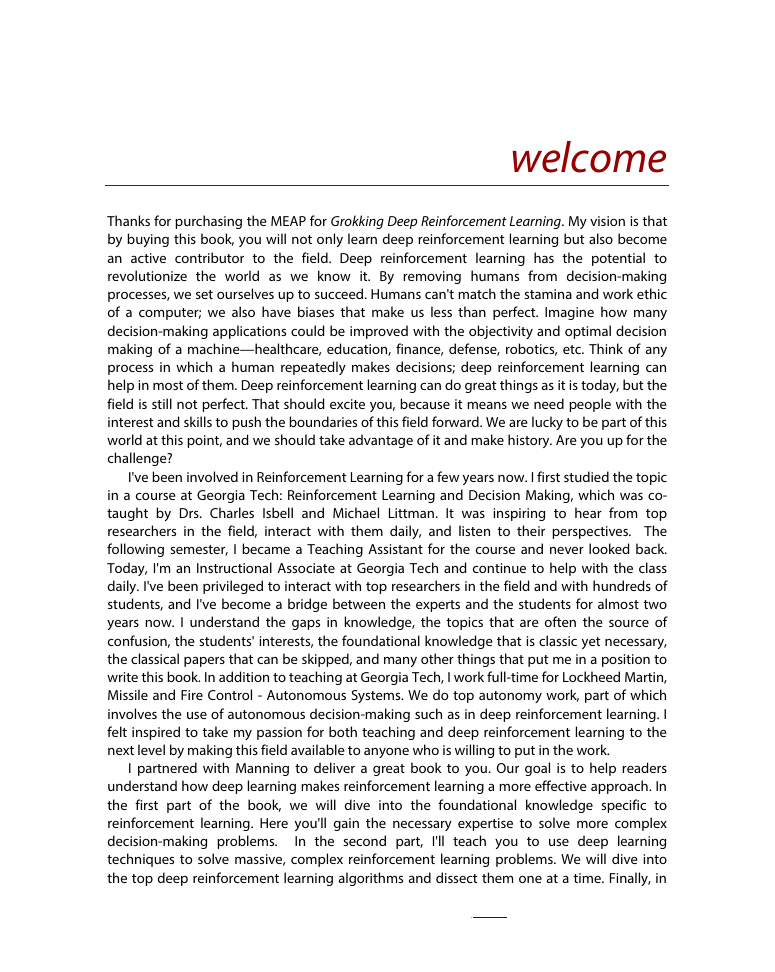


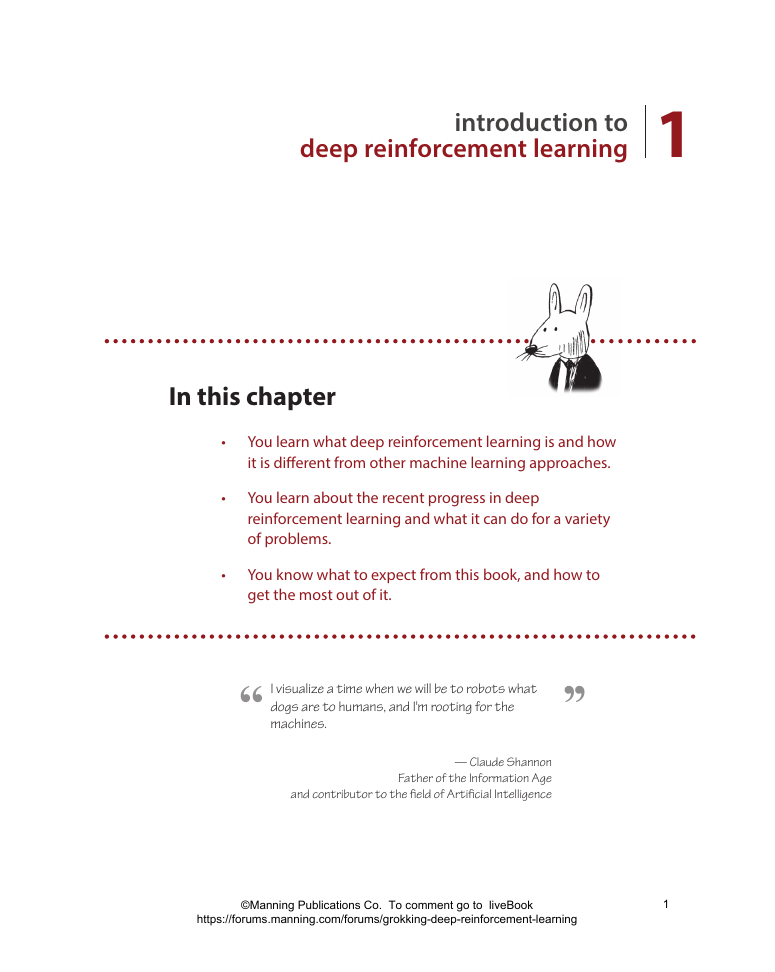
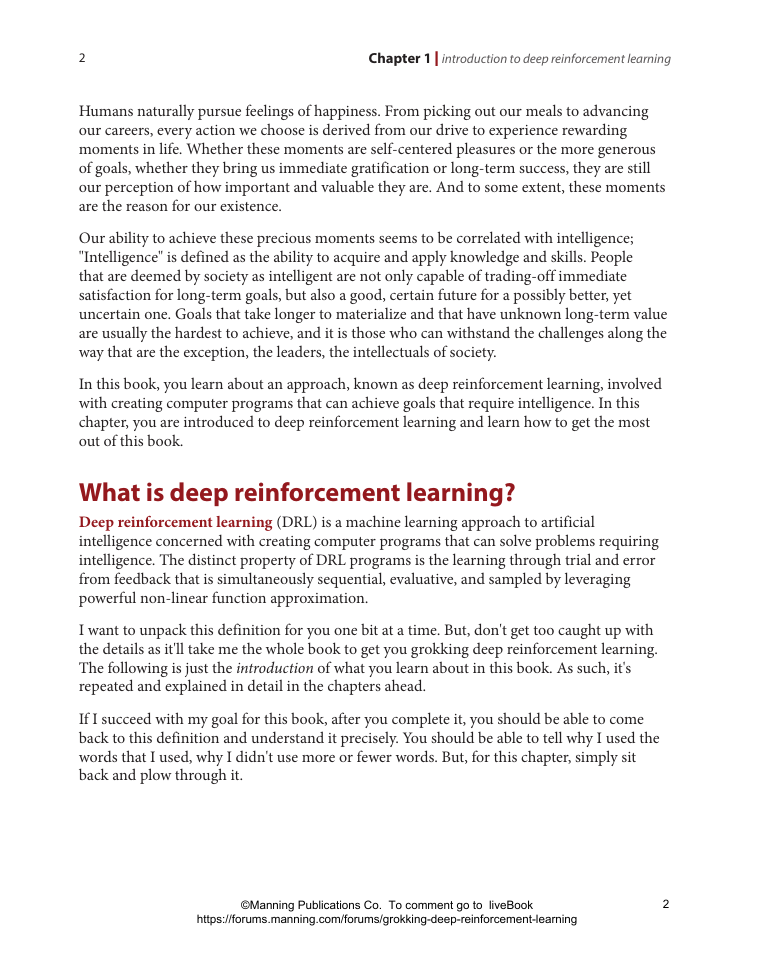
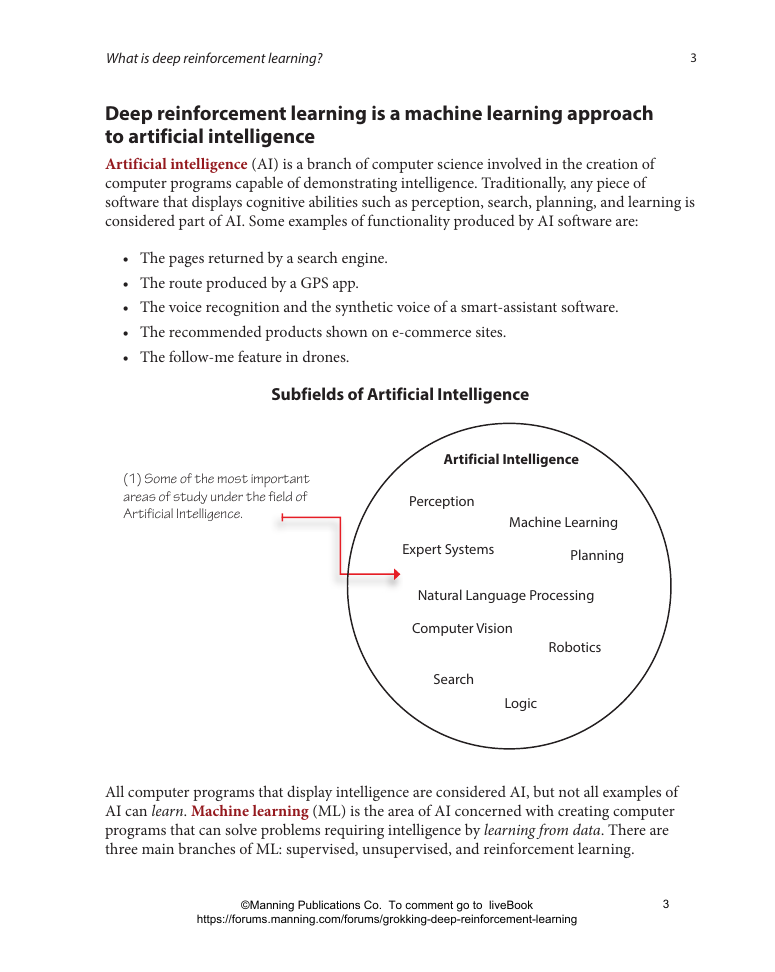








 2023年江西萍乡中考道德与法治真题及答案.doc
2023年江西萍乡中考道德与法治真题及答案.doc 2012年重庆南川中考生物真题及答案.doc
2012年重庆南川中考生物真题及答案.doc 2013年江西师范大学地理学综合及文艺理论基础考研真题.doc
2013年江西师范大学地理学综合及文艺理论基础考研真题.doc 2020年四川甘孜小升初语文真题及答案I卷.doc
2020年四川甘孜小升初语文真题及答案I卷.doc 2020年注册岩土工程师专业基础考试真题及答案.doc
2020年注册岩土工程师专业基础考试真题及答案.doc 2023-2024学年福建省厦门市九年级上学期数学月考试题及答案.doc
2023-2024学年福建省厦门市九年级上学期数学月考试题及答案.doc 2021-2022学年辽宁省沈阳市大东区九年级上学期语文期末试题及答案.doc
2021-2022学年辽宁省沈阳市大东区九年级上学期语文期末试题及答案.doc 2022-2023学年北京东城区初三第一学期物理期末试卷及答案.doc
2022-2023学年北京东城区初三第一学期物理期末试卷及答案.doc 2018上半年江西教师资格初中地理学科知识与教学能力真题及答案.doc
2018上半年江西教师资格初中地理学科知识与教学能力真题及答案.doc 2012年河北国家公务员申论考试真题及答案-省级.doc
2012年河北国家公务员申论考试真题及答案-省级.doc 2020-2021学年江苏省扬州市江都区邵樊片九年级上学期数学第一次质量检测试题及答案.doc
2020-2021学年江苏省扬州市江都区邵樊片九年级上学期数学第一次质量检测试题及答案.doc 2022下半年黑龙江教师资格证中学综合素质真题及答案.doc
2022下半年黑龙江教师资格证中学综合素质真题及答案.doc